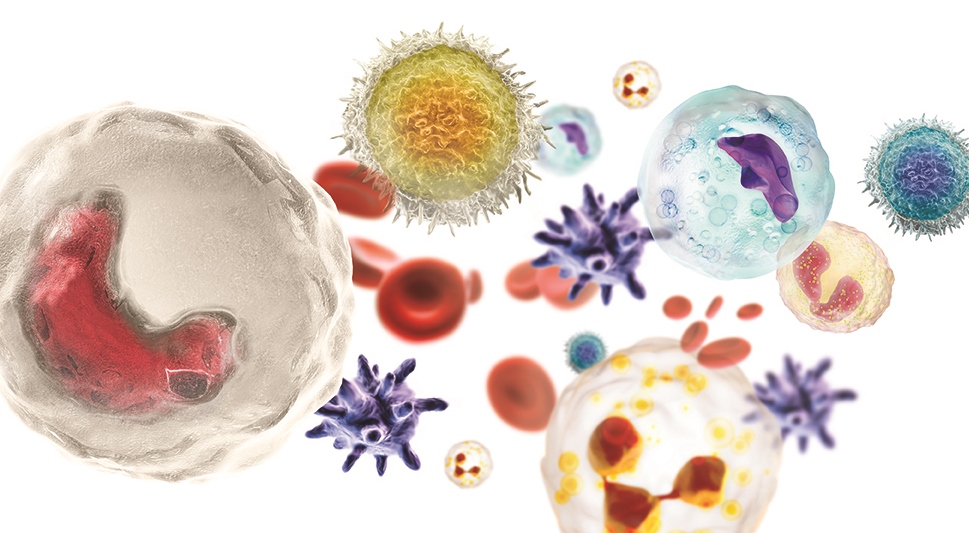Immune Cell Subtype Tied to Asthma in Mice Found in Humans With Viral Infections
Immune Cell Subtype Tied to Asthma in Mice Found in Humans With Viral Infections https://pediatricsnationwide.org/wp-content/uploads/2015/10/Pediatrics_Nationwide_feature_extra-art.jpg 969 533 Kevin Mayhood Kevin Mayhood https://secure.gravatar.com/avatar/bd57a8b155725b653da0c499ae1bf402?s=96&d=mm&r=g- January 16, 2018
- Kevin Mayhood

If asthma development in people parallels mice, the cells’ mechanisms may provide a target for disease prevention.
A subtype of neutrophil, labeled CD49d+ PMN, which is necessary to drive asthma and allergies in a mouse model, also accumulates in the nasal fluid of people with symptoms of an upper respiratory viral infection, researchers have discovered.
Neutrophils are the most common white blood cells in the immune system. The research team found that this subset in both the mouse model and infected humans expressed the protein cysteinyl leukotriene receptor 1 (CysLTR1). Upregulation of CysLTR1 is associated with asthma and allergic disease.
The team reported that administering the mouse equivalent of the drug montelukast, which blocks CysLTR1, during the first five days of a respiratory viral infection in the mouse model reduced lung accumulation of CD49d+ PMN and development of the mouse version of asthma. Their study is published in The Journal of Allergy and Clinical Immunology.
“If we treat the mice later — after the CD49d+ PMN have accumulated in the lung — we don’t prevent disease,” says Mitchell Grayson, MD, chief of the Division of Allergy and Immunology, a principal investigator in the Center for Clinical and Translational Research in The Research Institute at Nationwide Children’s and senior author of the study.
“The big takeaway,” says Dr. Grayson, who is also professor of Pediatrics at The Ohio State University College of Medicine, “is this study suggests that if disease development in people parallels that in the mouse model, we may be able to block accumulation of CD49d+ PMN in the respiratory tract of people during infancy, and thereby prevent development of asthma and allergic disease.”
The prevalence of asthma, allergic rhinitis and other allergic disease is increasing in developed countries. Nearly 300 million people suffer from asthma, and health experts expect the number to grow to 400 million by 2025. Patients suffer and lose days at school and work due to the disease. The cost of asthma is more than $1,000 per person annually in the United States and Europe, studies estimate.
The researchers found that CysLTR1 expression in the mouse model produced tumor necrosis factor, which is involved in antiviral activity, and the chemokines CCL2 and CCL5, which are involved in regulating immunity and inflammation. The findings helped Dr. Grayson and Lisa Martorano, DO, an Allergy/Immunology fellow at Nationwide Children’s, to develop a likely chain of mechanisms that lead from respiratory virus exposure to asthma. They published this chain in a review in the European Journal of Immunology.
Dr. Grayson and colleagues are now testing whether the CysLTR1 receptor on CD49d+ PMN functions in humans, and if blocking it prevents accumulation of these cells in the respiratory tract.
References:
- Cheung DS, Sigua JA, Simpson PM, Yan K, Hussain S-RA, Santoro JL, Buell EJ, Hunter DA, Rohlfing M, Patadia D, Grayson MH. CysLTR1-expression identifies a subset of neutrophils during the antiviral response that contributes to post-viral atopic airway disease.The Journal of Allergy and Clinical Immunology.S0091-6749(17)32913-5/abstract
- Martorano LM, Grayson MH. Respiratory viral infections and atopic development: From possible mechanisms to advances in treatment. European Journal of Immunology. 2017 Dec 15 [Epub ahead of print]
Photo credit: Adobe Stock
About the author
-
Kevin Mayhoodhttps://pediatricsnationwide.org/author/kevin-mayhood/
-
Kevin Mayhoodhttps://pediatricsnationwide.org/author/kevin-mayhood/April 25, 2015
-
Kevin Mayhoodhttps://pediatricsnationwide.org/author/kevin-mayhood/April 25, 2015
-
Kevin Mayhoodhttps://pediatricsnationwide.org/author/kevin-mayhood/April 25, 2015
- Posted In:
- In Brief






